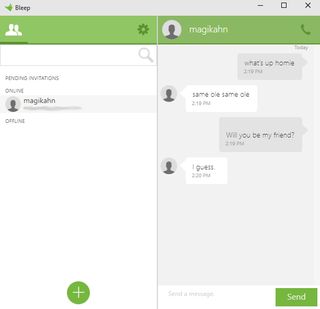BitTorrent Launches Bleep Chat To The Masses, Uses No Cloud

BitTorrent officially launched its chat client called Bleep on Tuesday. The service first made an appearance as a public alpha back in September 2014, but it's now available on all major platforms, including Apple's iOS, Google's Android, and Windows and Mac desktops.
So what's the big deal with Bleep? Why is it different than Skype, AIM and other chat clients?
"We keep messages and the encryption keys for images stored on your local device, not the cloud," said BitTorrent's Farid Fadaie in a blog. "For messages and metadata, there is no server for hackers to target, and because you hold the keys, images can't be leaked to haunt you later. We've solved serverless peer-to-peer messaging, including the ability to get offline friends your messages when they come back online."
For the desktop client, users can create an account by supplying an email address or phone number, or they can simply go incognito. If users enter an email address, this address must be confirmed by way of an emailed PIN composed of letters and numbers. After that, users can find and invite friends by connecting an address book or entering another user's key.
To add a contact, simply click on the "+" sign and enter a phone number, email address or public key. Your key, which is supplied as a QR code or a very lengthy string of numbers and letters, is located under the "Be added by friends" section in "Settings." Your friend won't become a Bleep contact until he/she provides an approval.
The overall Bleep interface is divided into two sections: the contacts area and the chat area. The contacts portion includes the "Settings" menu, a search tool, pending invitations, a list of contacts that are online, and a list that's offline. The right side provides a large conversation window and the text entry box at the bottom.
In addition to the basic chat functions, this new version of Bleep includes an added feature called "Whisper." To enter this mode, mobile phone users simply hit "Go to Whisper," and these conversations and images will be deleted off the sender's and recipient's devices 25 seconds after they have been viewed. For desktop users, simply hit the "SHIFT" button (Windows) or "CTRL" button (Mac) while sending a "whispered" message or image. Users can switch back and forth in a conversation when needed.
Stay on the Cutting Edge
Join the experts who read Tom's Hardware for the inside track on enthusiast PC tech news — and have for over 25 years. We'll send breaking news and in-depth reviews of CPUs, GPUs, AI, maker hardware and more straight to your inbox.
To assuage any fears that the other user is taking screenshots of the conversation during Whisper mode, Fadaie said that the screenshot in question won't show nicknames, so there's no way to see who said what. Tap the "eye" in the display, and the screenshot will show the nicknames but not the messages. The other user can only take screenshots of one or the other.
In addition to the chat features, there's a phone icon at the top that allows users to talk to friends for free over the Internet. Fadaie said that these calls connect directly and don't involve the cloud. Users can also rest assured that these calls feature end-to-end encryption; there's no eavesdropping by unsuspecting government agencies or hackers.
BitTorrent's Christian Averill explained to Tom's how Bleep actually works, saying that instead of supplying chat servers that store information, Bleep relies on the current BitTorrent ecosystem. When the Bleep client looks up contacts, it uses the DHT, which is "a web of peers" cooperating together. When the sender identifies a receiver, the message is sent directly to the receiver using end-to-end encryption. You can get a deeper explanation here.
Bleep's video support is there, but it's lacking. "Bleep core already supports video, but exposing it in the UI depends on what features (and how) users would like to see," he said. "There is definitely the possibility of exposing this feature but the timeline for it is TBD."
Bleep arrives in a time when Internet surfers are questioning the privacy of the tools they use to communicate on the Web. BitTorrent seems intent on fixing this issue with peer-to-peer software. Averill said that with cloud solutions, there's always a tradeoff between privacy and cool features. But that's not so with a peer-to-peer solution; you can have something that is fun and easy to use without compromising security.
When we asked if the company will eventually start charging for this service, Averill said, "Our current focus is to make the consumer app great, and we will continue doing that." But he added, "Having said that, Bleep is built to scale not only as a consumer app but also as a platform that can be offered to other companies to use (as an SDK, etc.). Other companies can easily integrate messaging functionalities into their own apps using Bleep engine without needing any servers (which is revolutionary in that it not only reduces the cost of operating servers but it also makes the conversation more private which opens the doors for new markets)."
"We will likely look into monetization potentials in those markets as we intend to keep the basic features of the consumer app free," Fadaie added.
So far the response to Bleep has been strong. Averill said that BitTorrent received a great deal of feedback from users during the alpha stages. Not only did these users help find bugs in the software; they also worked directly with the team.
Follow Kevin Parrish @exfileme. Follow us @tomshardware, on Facebook and on Google+.
-
lun471k The Android App is not even compatible with the Windows one yet, so you cannot connect both devices on the same account. The app does not even ask if you are an existing user and simply requires you to create another account.Reply
Most Popular


